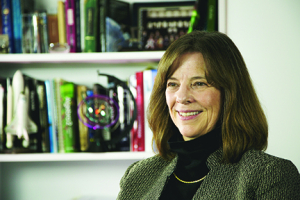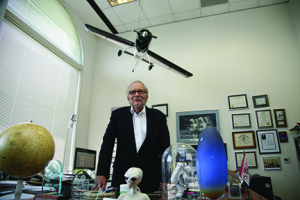The mystique of the most populous city in Texas was imprinted in the imaginations of people around the world when astronauts uttered “Houston” in their first communications from space during NASA’s heyday. Professor and former NASA astronaut Bonnie J. Dunbar, who serves as director of UH Cullen College of Engineering’s aerospace engineering and SICSA space architecture programs, looks forward to the day when space exploration again transfixes people of every nation.
Unlike the mid-20th Century when rockets were first successfully developed and only two countries dominated space exploration, many nations now are space-faring. They are launching rockets and even astronauts into the cosmos as well as their own communication, weather, remote sensing and navigation satellites, Dunbar said.
“Both space exploration and space commerce are now internationally competitive,” Dunbar said. “As the NASA budget is increased beyond its half-percent of the federal budget, and space commerce is moving to Texas, it is important that the University of Houston, with its proximity to the NASA Johnson Space Center and the Ellington Field spaceport, be poised to be part of this new bold future.”
Last fall, the Sasakawa International Center for Space Architecture (SICSA), which is the only program of its kind in the world, moved from the UH Gerald D. Hines College of Architecture to the UH Cullen College of Engineering. The change ushered in an interdisciplinary space architecture education for graduate students that involves engineers and technical architects designing missions and operations from the ground up, including orbital mechanics, human habitats, logistics, design for extreme environments, life support systems, human factors and launch capability trades.
Both aerospace engineering and space architecture are yearlong, 30-credit-hour master’s degree programs. The aerospace engineering curriculum offers students one of three concentrations: aerodynamics and heat transfer, structural mechanics and materials, or controls and automation. The space architecture program, which was established in 1987 and accredited in 2002 by the Texas Higher Education Coordinating Board (THECB), has both team studio and individual thesis options.
The aerospace engineering program is multidisciplinary, merging engineering and physics with course topics including smart structures, space radiation protection, robotic systems, spacecraft design and propulsion. In a unique agreement, UH students may also take complementary courses at Rice University and apply as many as six credits to their degrees.
Dunbar has submitted several grant proposals to NASA, and has revived space-related research projects with other UH professors since she inherited the aerospace engineering program in 2013. Her goals are to continue the program’s award-winning small satellite antenna research and to expand the UH Small Satellite Research Laboratory to accommodate the full range of technologies necessary for CubeSat missions. She also plans to establish professional certificate and doctoral programs while she works to grow numbers of students enrolled in the aerospace engineering and space architecture master’s programs.
“Space architecture is different from any other program, so it complements the college of engineering and enlarges our offering to the community,” Dunbar said. “It’s very much like a small company when engineers and architects team up to produce fully designed habitats, not just parts of systems, which they take into full operation, including logistical resupply.”
Architecture professor Larry Bell founded the interdisciplinary space architecture program in 1987. For almost 30 years, his students also used holistic logic to create life support systems in space, subsea, Arctic and other extreme habitats.
“I believe Dr. Dunbar’s presence is a game changer because she brings real experience of having been through NASA programs, and microgravity is a very different kind of environment,” Bell said. “She brings the experiential side as well as being attuned to a broad comprehensive array of issues and technical challenges that bring something very special to the whole opportunity.”
Space architecture and aerospace engineering programs take macro and micro approaches to the same problems, so their recent partnership gives engineers and architects opportunities to establish common languages that cut across disciplines, Bell said.
“There is an understanding of how fortunate we are to have this kind of two-sides-of-the-same-coin mating,” Bell said. “It’s not them and us – it’s all us – and we’re solving problems together.”
Bell became a senior faculty member with the SICSA team when the program moved to the engineering college last year. He began his academic career as director of the graduate industrial design program at the University of Illinois, but Houston, which he described as “a dynamic bastion of free enterprise,” attracted him to the University of Houston. He began teaching architecture classes in 1978.
“I really wasn’t a space cadet at that time,” Bell said. “I never had more than an average amount of interest in space in my past.”
However, NASA’s exotic challenges and problem-solving opportunities immediately captured Bell’s fascination, and his interests were contagious among his fellow faculty members. The college soon implemented design studios and earned funded contracts from NASA and aerospace companies.
“We draw on experiences of people who have been to space, and then extrapolate lessons into conceptual designs,” he said.
The central program priority is to provide a resource-rich, interactive learning environment that enables students to pursue professional goals that mesh with opportunities. The learning is not linear, which attracts proactive students.
“Academia is generally a narrowing process rather than an expanding one as students ascend the pyramid of learning,” Bell said. “But space architecture is an expanding journey that looks at issues and problems holistically.”
Human attitudes do not come in standards that engineers and architects can measure on scales. As individuals, people have different backgrounds, desires and expectations, and the additions of stress and gender dynamics in isolated situations make it more interesting, Bell said.
“We learn by jumping into the deep end of the pool together – full immersion – and, you know, I haven’t drowned anyone yet,” Bell said. “And then they go out into the world with confidence, skills and experiences essential for success.”
Students and alumni work for organizations, including NASA, the European Space Station, the Houston Spaceport and commercial aerospace companies, which often pay their tuition. Many students have also worked for Bell, whom co-founded several commercial space enterprises throughout the years.
“Our students are very mature,” Bell said. “I would put their work up against any professional organization.”
Bell and Trotti, Inc. provided space station research, design and full-scale mockup fabrication services for leading aerospace firms. International Space Enterprises, a San Diego-based company, teamed up with Russian organizations to develop telerobotic rovers to explore lunar and planetary surfaces. The company then spun off a subsidiary that designed and built advanced hybrid buses and trucks. Still another company, Space Industries, Inc., grew from four co-founders to more than 8,000 professional employees through a series of mergers and acquisitions.
“Houston provided an ideal business climate for such enterprises,” Bell said. “We can be very grateful for its rich diversity of talent and resources, which include the NASA community, the Texas Medical Center and a variety of other high-tech industries.”
The Texas Medical Center, which is one of the largest medical centers in the world, provides tremendous technical resources for UH students and alumni, Bell said. Houston has the diversity of talent and resources to provide entrepreneurial know-how that supports commercialization.
“They could not have started space industries in Tucson, Arizona,” Bell said. “It required some wildcat, risk-willing people who would invest in crazy ideas that turned out to be not so crazy after all.”

